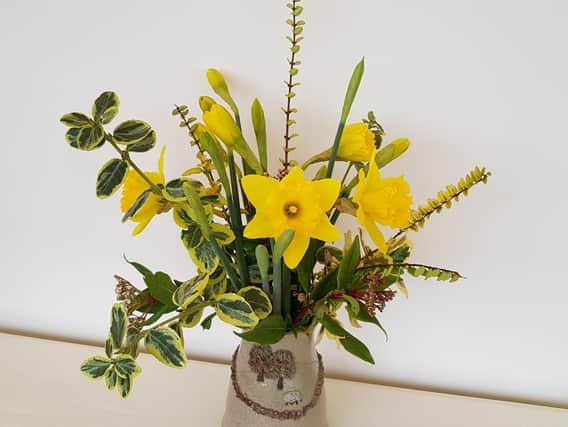GARDENING: Signs of spring time bring a feeling of hope


The first bulb shoots appeared early this month and have already taken a few severe frosts in their stride thanks to nature`s survival strategy. The trigger for action is a plummeting temperature which causes cell water to be transferred via their plumbing system, from peripheral areas to deep in the plant where it’s held for the duration. When the thaw arrives, it is returned to the surface cells. Equilibrium restored, they drive on toward flowering.
Similarly, a few containers of dwarf narcissi and the taller, fragrant `Paper White` are coming along nicely in the unheated greenhouse. Anyone doubting their hardiness should have seen them recently when minus four Celsius was recorded overnight on the thermometer. Next morning, first inspection of the day, found them frozen solid, compost and all. What
survivors they are!
Advertisement
Hide AdAdvertisement
Hide AdWhile our garden bulbs are on the steady road to flowering, there`s no harm in whetting the appetite by purchasing daffodils arriving in bunches from Cornwall and displayed in local supermarkets for £1.00. Depending on where they`re bought, I`ve discovered, the number in a bunch can vary from ten to sixteen. We have two vases on the kitchen windowsill that offer continuity. Whereas those bought last week are in full, glorious bloom, those purchased two days ago are just breaking bud. The flowers remain fresh for 7 to 10 days and we add a few stems of evergreen shrubs, which eventually form roots if they`re retained when the water is changed for an incoming bunch. This is a simple way of creating young plants for the garden.
Another indoor treat is presenting itself in the garden as spring flowering shrubs begin to stir. They`re a few weeks away from blooming but if you remove some stems and stand them in a vase of water on the warm kitchen windowsill, they`ll do the rest. Look for early bud growth on my three favourites, flowering currant (ribes), willow (salix) and forsythia.
If you saved polyanthus plants from last spring`s displays and they`re overwintering on a spare piece of land, it`s worth potting-up a few and bringing them in from the cold. They`ll reward you with early colour. Although winter may still hold unpleasant surprises it's time to start upping our game, weather permitting, or face playing catch-up later. February 1 st is the magical date I switch on the soil-warming cable in our propagating box and set it to work.
Over the coming weeks it will host seeds of early vegetables and ornamental plants in pots and cell trays. The chrysanthemum stools saved from last season are already showing a few sturdy growths, so stem cuttings will be taken from those in mid-February. Most of our dahlias remain in the garden permanently but any newcomers with an appealing form or colour are brought into the greenhouse. Shoots that emerge from those tubers are destined to become stem cuttings too. They will be planted out at the end of May and flower this year.
Advertisement
Hide AdAdvertisement
Hide AdWe are harvesting the final, large pot of new potato `Charlotte` that was grown alongside others in the greenhouse for winter treats. But there`s no resting on our laurels with Easter just over the horizon. Allowing ten weeks for growth, planting time is now but where are the seed potatoes? Answer, lurking in a dark cupboard under the stairs. I took a handful from the weekly shopping
a while ago and now they have shoots. Yes, it works! Pruning continues in the garden and there are two outstanding candidates for attention before new growth takes off. A green leafed holly, Ilex aquifolium, must be reduced in height before it becomes a monster, and a beech hedge that presents a broad challenge at trimming time, must be reduced in width. The latter will be trimmed on one side only this year to maintain privacy. Sorry for the temporary inconvenience birds but you will benefit from this in the long run!